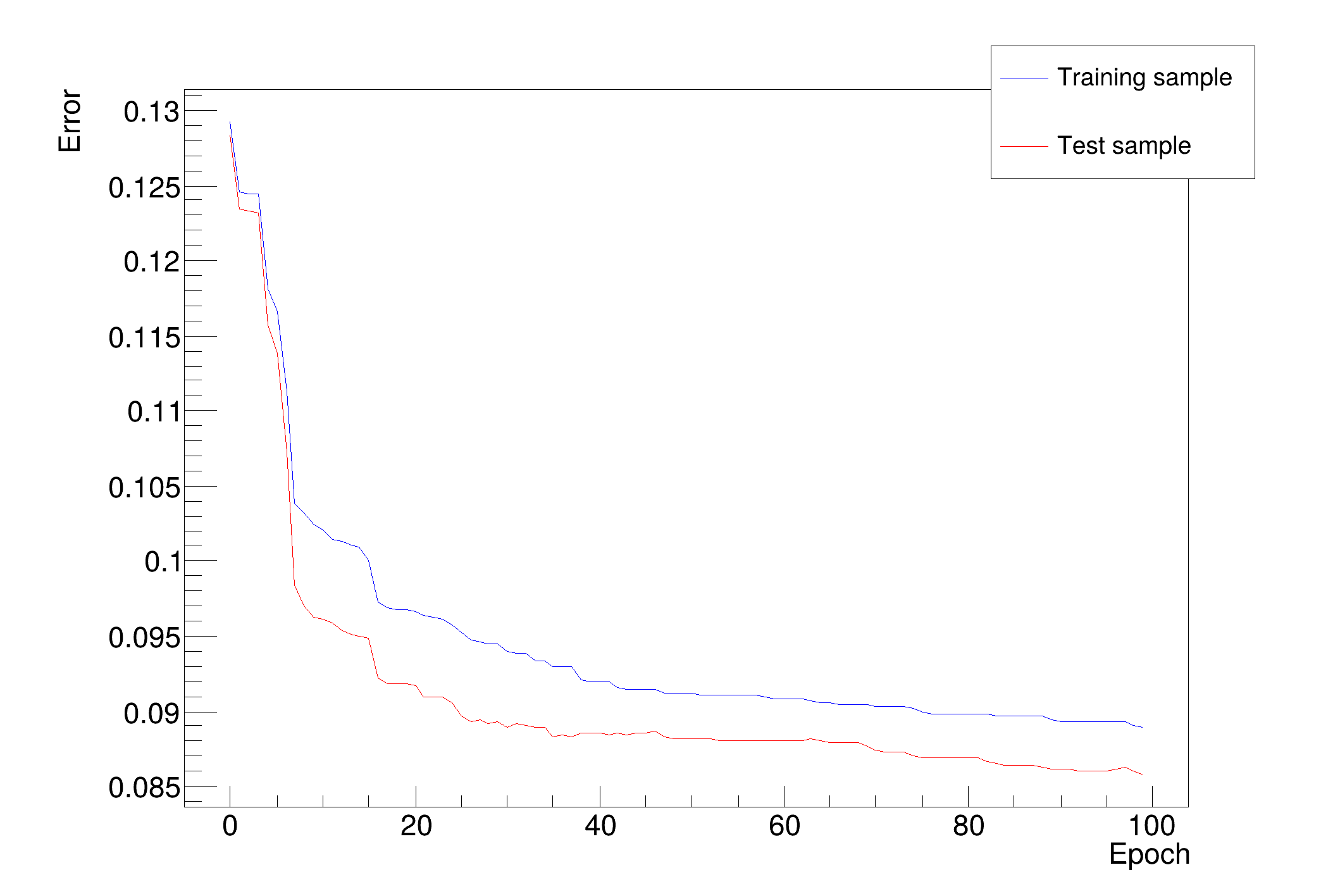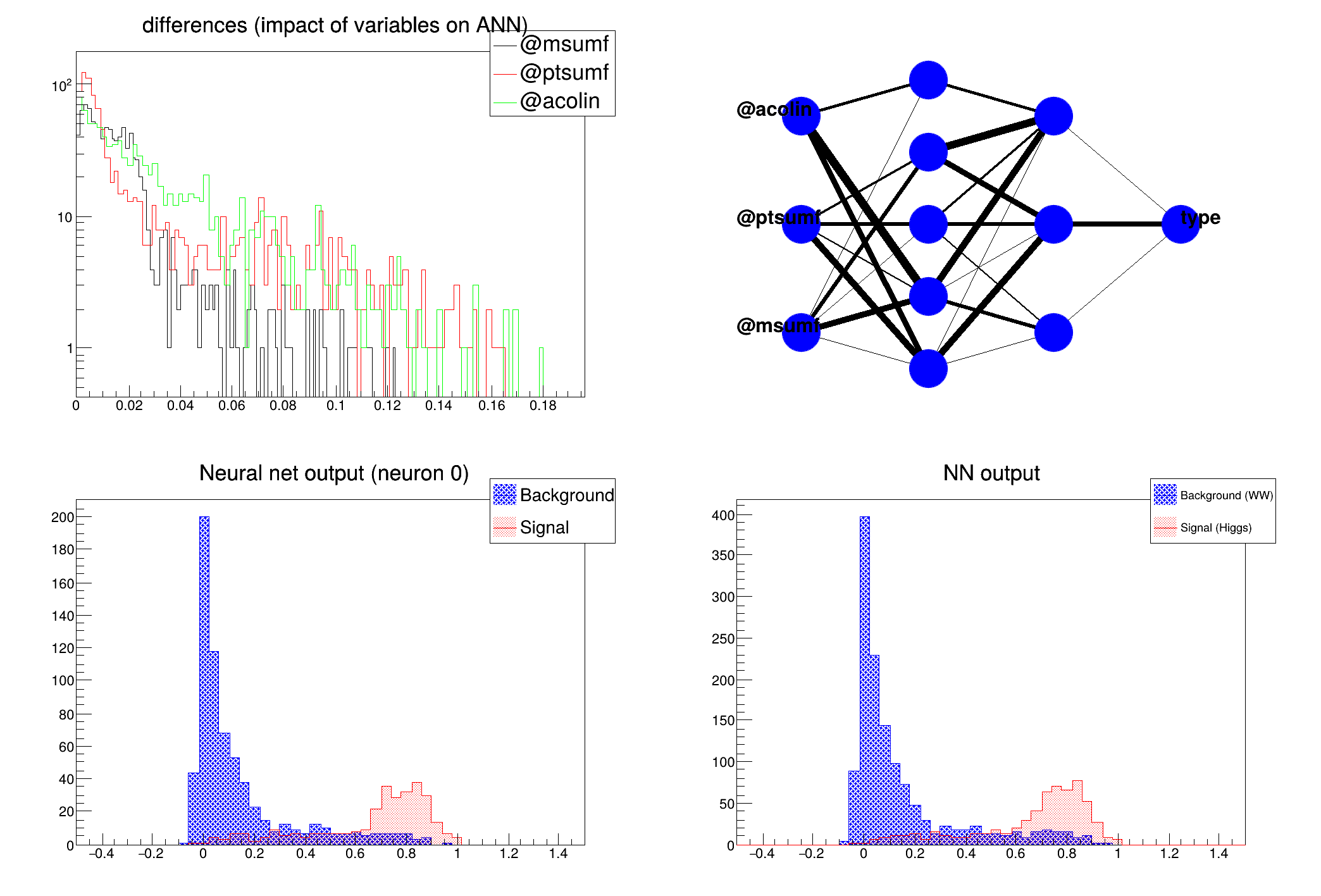Example of a Multi Layer Perceptron For a LEP search for invisible Higgs boson, a neural network was used to separate the signal from the background passing some selection cuts.
Here is a simplified version of this network, taking into account only WW events.
Training the Neural Network
Epoch: 0 learn=0.126634 test=0.125724
Epoch: 10 learn=0.0934813 test=0.0889442
Epoch: 20 learn=0.092216 test=0.0884365
Epoch: 30 learn=0.0916077 test=0.0884488
Epoch: 40 learn=0.0909588 test=0.0878387
Epoch: 50 learn=0.0906525 test=0.0871386
Epoch: 60 learn=0.090363 test=0.087412
Epoch: 70 learn=0.0902461 test=0.0873363
Epoch: 80 learn=0.090015 test=0.0872118
Epoch: 90 learn=0.0898752 test=0.0874495
Epoch: 99 learn=0.0897188 test=0.0870232
Training done.
test.py created.
Network with structure: @msumf,@ptsumf,@acolin:5:3:type
inputs with low values in the differences plot may not be needed
@msumf -> 0.0141541 +/- 0.0144544
@ptsumf -> 0.0328397 +/- 0.0416611
@acolin -> 0.0210956 +/- 0.0347819
const char *
fname =
"mlpHiggs.root";
} else {
printf(
"accessing %s file from http://root.cern/files\n",
fname);
}
simu->Branch(
"nch", &
nch,
"nch/F");
}
}
"ptsumf",
simu,
"Entry$%2",
"(Entry$+1)%2");
ana.GatherInformations();
ana.DrawNetwork(0,
"type==1",
"type==0");
TH1F *
bg =
new TH1F(
"bgh",
"NN output", 50, -.5, 1.5);
TH1F *sig =
new TH1F(
"sigh",
"NN output", 50, -.5, 1.5);
}
}
bg->SetFillStyle(3008);
bg->SetFillColor(
kBlue);
legend->AddEntry(
bg,
"Background (WW)");
legend->AddEntry(sig,
"Signal (Higgs)");
}
int Int_t
Signed integer 4 bytes (int)
float Float_t
Float 4 bytes (float)
double Double_t
Double 8 bytes.
ROOT::Detail::TRangeCast< T, true > TRangeDynCast
TRangeDynCast is an adapter class that allows the typed iteration through a TCollection.
Option_t Option_t TPoint TPoint const char GetTextMagnitude GetFillStyle GetLineColor GetLineWidth GetMarkerStyle GetTextAlign GetTextColor GetTextSize void input
Option_t Option_t TPoint TPoint const char GetTextMagnitude GetFillStyle GetLineColor GetLineWidth GetMarkerStyle GetTextAlign GetTextColor GetTextSize void char Point_t Rectangle_t WindowAttributes_t Float_t Float_t Float_t Int_t Int_t UInt_t UInt_t Rectangle_t Int_t Int_t Window_t TString Int_t GCValues_t GetPrimarySelectionOwner GetDisplay GetScreen GetColormap GetNativeEvent const char const char dpyName wid window const char font_name cursor keysym reg const char only_if_exist regb h Point_t winding char text const char depth char const char Int_t count const char ColorStruct_t color const char Pixmap_t Pixmap_t PictureAttributes_t attr const char char ret_data h unsigned char height h Atom_t Int_t ULong_t ULong_t unsigned char prop_list Atom_t Atom_t Atom_t Time_t type
char * Form(const char *fmt,...)
Formats a string in a circular formatting buffer.
R__EXTERN TSystem * gSystem
virtual void SetFillColor(Color_t fcolor)
Set the fill area color.
virtual void SetFillStyle(Style_t fstyle)
Set the fill area style.
virtual void SetLineColor(Color_t lcolor)
Set the line color.
A ROOT file is an on-disk file, usually with extension .root, that stores objects in a file-system-li...
static TFile * Open(const char *name, Option_t *option="", const char *ftitle="", Int_t compress=ROOT::RCompressionSetting::EDefaults::kUseCompiledDefault, Int_t netopt=0)
Create / open a file.
1-D histogram with a float per channel (see TH1 documentation)
virtual void SetDirectory(TDirectory *dir)
By default, when a histogram is created, it is added to the list of histogram objects in the current ...
virtual Int_t Fill(Double_t x)
Increment bin with abscissa X by 1.
void Draw(Option_t *option="") override
Draw this histogram with options.
virtual void SetStats(Bool_t stats=kTRUE)
Set statistics option on/off.
This class displays a legend box (TPaveText) containing several legend entries.
This utility class contains a set of tests useful when developing a neural network.
This class describes a neural network.
Double_t Evaluate(Int_t index, Double_t *params) const
Returns the Neural Net for a given set of input parameters #parameters must equal #input neurons.
void Export(Option_t *filename="NNfunction", Option_t *language="C++") const
Exports the NN as a function for any non-ROOT-dependant code Supported languages are: only C++ ,...
void Train(Int_t nEpoch, Option_t *option="text", Double_t minE=0)
Train the network.
void Draw(Option_t *option="") override
Draws the network structure.
static const TString & GetTutorialDir()
Get the tutorials directory in the installation. Static utility function.
virtual Bool_t AccessPathName(const char *path, EAccessMode mode=kFileExists)
Returns FALSE if one can access a file using the specified access mode.
A TTree represents a columnar dataset.

